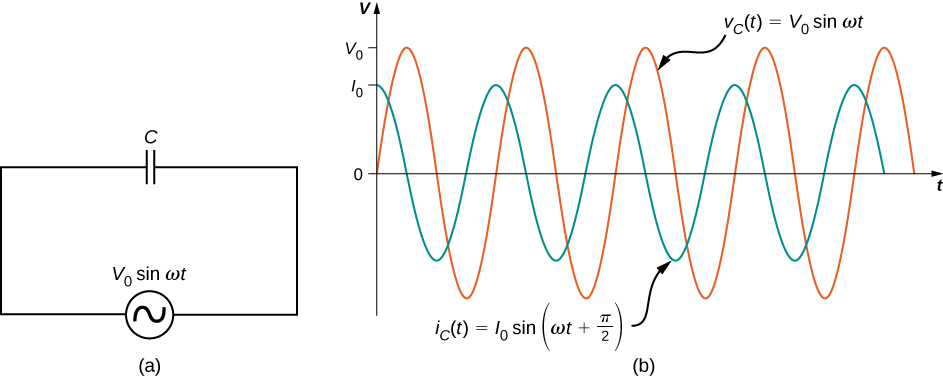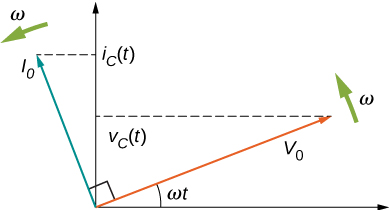| << Chapter < Page | Chapter >> Page > |
Now let’s consider a capacitor connected across an ac voltage source. From Kirchhoff’s loop rule, the instantaneous voltage across the capacitor of [link] (a) is
Recall that the charge in a capacitor is given by This is true at any time measured in the ac cycle of voltage. Consequently, the instantaneous charge on the capacitor is
Since the current in the circuit is the rate at which charge enters (or leaves) the capacitor,
where is the current amplitude. Using the trigonometric relationship we may express the instantaneous current as
Dividing by , we obtain an equation that looks similar to Ohm’s law:
The quantity is analogous to resistance in a dc circuit in the sense that both quantities are a ratio of a voltage to a current. As a result, they have the same unit, the ohm. Keep in mind, however, that a capacitor stores and discharges electric energy, whereas a resistor dissipates it. The quantity is known as the capacitive reactance of the capacitor, or the opposition of a capacitor to a change in current. It depends inversely on the frequency of the ac source—high frequency leads to low capacitive reactance.

A comparison of the expressions for and shows that there is a phase difference of between them. When these two quantities are plotted together, the current peaks a quarter cycle (or ) ahead of the voltage, as illustrated in [link] (b). The current through a capacitor leads the voltage across a capacitor by or a quarter of a cycle.
The corresponding phasor diagram is shown in [link] . Here, the relationship between and is represented by having their phasors rotate at the same angular frequency, with the current phasor leading by

To this point, we have exclusively been using peak values of the current or voltage in our discussion, namely, and However, if we average out the values of current or voltage, these values are zero. Therefore, we often use a second convention called the root mean square value, or rms value, in discussions of current and voltage. The rms operates in reverse of the terminology. First, you square the function, next, you take the mean, and then, you find the square root. As a result, the rms values of current and voltage are not zero. Appliances and devices are commonly quoted with rms values for their operations, rather than peak values. We indicate rms values with a subscript attached to a capital letter (such as ).
Although a capacitor is basically an open circuit, an rms current , or the root mean square of the current, appears in a circuit with an ac voltage applied to a capacitor. Consider that

Notification Switch
Would you like to follow the 'University physics volume 2' conversation and receive update notifications?